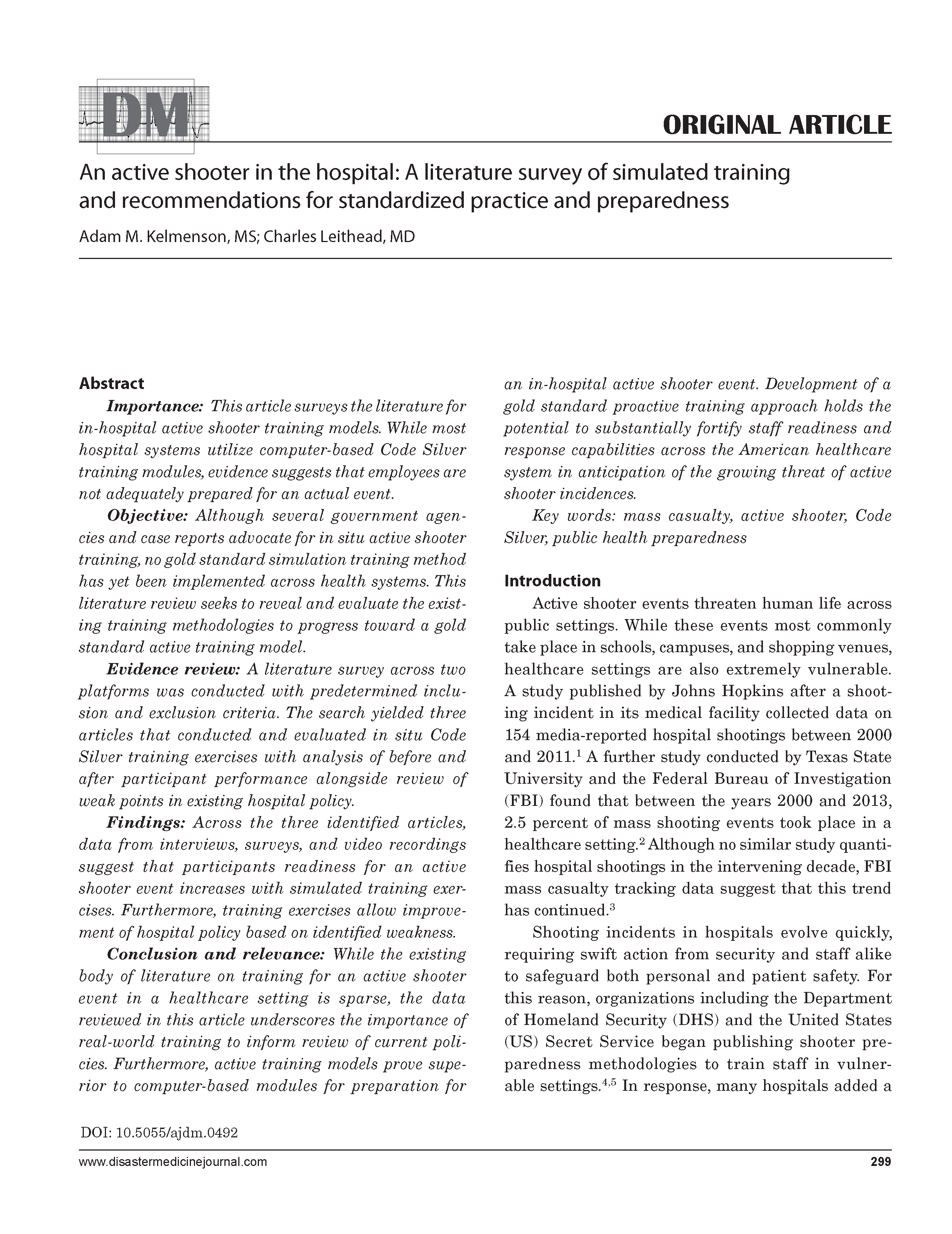An active shooter in the hospital: A literature survey of simulated training and recommendations for standardized practice and preparedness
DOI:
https://doi.org/10.5055/ajdm.0492Keywords:
mass casualty, active shooter, Code Silver, public health preparednessAbstract
Importance: This article surveys the literature for in-hospital active shooter training models. While most hospital systems utilize computer-based Code Silver training modules, evidence suggests that employees are not adequately prepared for an actual event.
Objective: Although several government agencies and case reports advocate for in situ active shooter training, no gold standard simulation training method has yet been implemented across health systems. This literature review seeks to reveal and evaluate the existing training methodologies to progress toward a gold standard active training model.
Evidence review: A literature survey across two platforms was conducted with predetermined inclusion and exclusion criteria. The search yielded three articles that conducted and evaluated in situ Code Silver training exercises with analysis of before and after participant performance alongside review of weak points in existing hospital policy.
Findings: Across the three identified articles, data from interviews, surveys, and video recordings suggest that participants readiness for an active shooter event increases with simulated training exercises. Furthermore, training exercises allow improvement of hospital policy based on identified weakness.
Conclusion and relevance: While the existing body of literature on training for an active shooter event in a healthcare setting is sparse, the data reviewed in this article underscores the importance of real-world training to inform review of current policies. Furthermore, active training models prove superior to computer-based modules for preparation for an in-hospital active shooter event. Development of a gold standard proactive training approach holds the potential to substantially fortify staff readiness and response capabilities across the American healthcare system in anticipation of the growing threat of active shooter incidences.
References
Kelen MGD, Catlett CL, Kubit JG, et al.: Hospital-based shootings in the United States: 2000 to 2011. Ann Emerg Med. 2012; 60(6): 790-798.e1. DOI: https://doi.org/10.1016/j.annemergmed.2012.08.012
Federal Bureau of Investigation (FBI): A Study of Active Shooter Incidents in the United States Between 2000 and 2013. Washington, DC: FBI, 2013.
FBI: Active shooter resources. 2023. Available at https://www.fbi.gov/how-we-can-help-you/safety-resources/active-shooter-safetyresources. Accessed August 23, 2024.
Vossekuil B, Reddy M, Borum R, et al.: The Final Report and Findings of the Safe School Initiative. Washington, DC: Service USS, 2004.
US Department of Homeland Security: Active shooter how to respond. 2008. Available at https://www.dhs.gov/xlibrary/assets/active_shooter_booklet.pdf. Accessed August 24, 2024.
McGowan M, Dainty K, Seaton B, et al.: Are we ready for a gunman in the emergency department? A qualitative study of staff perceptions of risk and readiness to respond. Can J Emerg Med. 2018; 20(P025): S65-S66. DOI: https://doi.org/10.1017/cem.2018.223
US Department of Homeland Security: Incorporating active shooter incident planning into health care facility emergency operations plans. 2014. Available at https://www.phe.gov/preparedness/planning/Documents/active-shooter-planning-eop2014.pdf. Accessed November 13, 2024.
Jacobs LM: The Hartford consensus: Survey of the public and healthcare professionals on active shooter events in hospitals. J Am Coll Surg. 2017; 225(3): 435-442. DOI: https://doi.org/10.1016/j.jamcollsurg.2017.06.009
Schafer JA, Giblin MJ, Burruss GW, Jr: Critical incident preparedness and response on post-secondary campuses. J Crim Just. 2010; 38: 311-317. DOI: https://doi.org/10.1016/j.jcrimjus.2010.03.005
International Association of Emergency Medical Services Chiefs: Active Shooter Planning and Response. Washington, DC: International Association of Emergency Medical Services Chiefs, 2017.
Comission TJ: Quick safety 4: Preparing for active shooter situations (updated June 2021). Update: June 2021. 2024. Available at https://www.jointcommission.org/resources/news-and-multimedia/newsletters/newsletters/quick-safety/quick-safety--issue-4-preparing-for-active-shooter-situations/. Accessed November 13, 2024.
Phelps SRR, Doering G: Model “code silver” internal lockdown policy in response to active shooters. Am J Disaster Med. 2007; 2(3): 143-150. DOI: https://doi.org/10.5055/ajdm.2007.0023
Goralnick EW: An active shooter in our hospital. Lancet. 2015; 385(9979): 1728. DOI: https://doi.org/10.1016/S0140-6736(15)60891-1
Wexler BF: Lessons learned from an active shooter full-scale functional exercise in a newly constructed emergency department. Disaster Med Public Health Prep. 2017; 11(5): 522-525. DOI: https://doi.org/10.1017/dmp.2016.181
Phillips J: Workplace violence against health care workers in the United States. N Engl J Med. 2016; 374(17): 1661-1669. DOI: https://doi.org/10.1056/NEJMra1501998
Argintaru N, Li W, Hicks C, et al.: An active shooter in your hospital: A novel method to develop a response policy using in situ simulation and video framework analysis. Disaster Med Public Health Prep. 2021; 15(2): 223-231. DOI: https://doi.org/10.1017/dmp.2019.161
Kim JJ, Howes D, Forristal C, et al.: The code silver exercise: A low-cost simulation alternative to prepare hospitals for an active shooter event. Adv Simul. 2021; 6(1): 37. DOI: https://doi.org/10.1186/s41077-021-00190-0
Brown RG, Anderson S, Brunt B, et al.: Workplace violence training using simulation. Am J Nurs. 2018; 118(10): 56-68. DOI: https://doi.org/10.1097/01.NAJ.0000546382.12045.54
USGA Office: Workplace Safety and Health: Additional Efforts Are Needed to Help Protect Health Care Workers from Workplace Violence. Contract No.: GAO-16-11. Washington, DC: USGA, 2016.
US Department of Labor OSaHA: Guidelines for Preventing Workplace Violence for Healthcare and Social Service Workers. Contract No.: OSHA 3148-06R. Washington, DC: OSHA, 2016.

Published
How to Cite
Issue
Section
License
Copyright 2007-2025, Weston Medical Publishing, LLC and American Journal of Disaster Medicine. All Rights Reserved.

